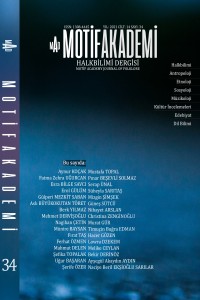Öz
Arkeolojik buluntular bize çömlekçiliğin, Anadolu coğrafyasının uzun geçmişinden gelen önemli bir gelenek ve maddi kültür unsuru olduğunu göstermektedir. Aynı zamanda pişmiş toprağın yok edilemeyen bir malzeme olması, geçmişin belgelerini günümüze ulaştırması bakımından ayrı bir değer ifade etmektedir. Anadolu’nun hemen her alanında varlığına şahit olduğumuz ilkel çömlekçilik, Göller Bölgesi’nin zengin prehistorik geçmişine koşut sayabileceğimiz nispette, birçok merkezde yoğun örnekleriyle karşımıza çıkmaktadır. Binlerce yıllık bir geleneğin bazı çömlekçilik merkezlerinde primitif halini bozmadan nerdeyse kesintisiz olarak günümüze kadar ulaşması kuşkusuz heyecan vericidir.
Başlangıcından beri bir zanaat biçimi olarak üretim eylemseli fazla değişime uğramaksızın süregelen çömlekçilik, kendini tüm Anadolu’da ve özellikle Göller Bölgesinde arkeolojik ve etnografik anlamda çok aktif olarak göstermesine rağmen günümüze ulaşan birkaç merkez dışında yok olmuş durumdadır. Bu merkezlerden biri de Konya iline bağlı Hüyük ilçesidir. Bugün son çömlekçi ustasının vefatıyla sonlanma belirtileri gösteren Hüyük çömlekçiliği, tüm olumsuz koşullarına karşın yine de bir direnme içindedir. Bu makalede çömlekçiliği canlandırmaya yönelik gayretin yanı sıra, önemli bir kültürel mirasın korunması kapsamında Hüyük çömlekçiliğinin yerel özellikleri anlatılmaya çalışılmıştır. Makale, yerinde (sahada) ilkel çömlekçilik araştırma yöntemi kullanılarak yazılmıştır.
Anahtar Kelimeler
Kaynakça
- Aksoy, R. - Bozdağ, A. (2008) Doğanhisar-Hüyük (Konya) arasında Sultandağları masifinin yapısal özellikleri. Selçuk Üniversitesi Mühendislik Mimarlık Fakültesi Dergisi, 23 (2), 37-45.
- Özkan, S. - Erdalkıran, M. (2014) Yeni buluntuların ışığında Çukurkent neolitik yerleşimi. ADALYA, No XVII/2014, 25-36.
- Mevlana Kalkınma Projesi, (2012) Hüyük İlçe Raporu (Proje) TR52, 10, Konya.
- URL-1: http://www.konev.org.tr/konya/ilcelerimiz.htm (Erişim: 17.01.2021) / URL-2: https://huyuk.bel.tr/sayfa/tarihce/ (Erişim: 21.01.2021)
- Görsel1.https://cdnacikogretim.istanbul.edu.tr/auzefcontent/20_21_Guz/turkiye_kiyi_bolgeler (Erişim: 20.01.2021) /Görsel 2. https://huyuk.bel.tr/sayfa/tarihce/ (Erişim: 16.02.2021) / Görsel 3.6.7.9.10.11.12.13: Fotoğraf Çekimi: Serap Ünal / Görsel4.https://www.aa.com.tr/tr/yasam/yeni-nesil-toprak-urunleri-bilmiyor/1241600 (Erişim: 18.12.2020) /Görsel 5. http://www.yenimeram.com.tr/yeni-nesil-toprak-urunleri-bilmiyor-301943.htm (Erişim: 18.12.2020)Görsel 8. Çizim: Serap Ünal
Öz
Archaeological findings show us that pottery is an important tradition and material culture element in the Anatolian geography from its long past. At the same time, the fact that the baked soil is a material that cannot be destroyed means a special value in terms of bringing the documents of the past to the present. Primitive pottery, which we witness in almost every area of Anatolia, appears with intense examples in many centers in this region to the extent that we can count parallel to the prehistoric rich history of the Lakes Region. It is undoubtedly exciting that a tradition of thousands of years survives almost uninterruptedly in some pottery centers without breaking its primitive state.
Pottery, which has been continuing as a craft form without much change since the beginning, has disappeared except for a few centers that have survived to the present day, although it shows itself very actively in the archaeological and ethnographic sense in all Anatolia and especially in the Lakes Region. One of these centers is Hüyük district of Konya province. Hüyük pottery, which shows signs of ending with the death of the last potter master, still resists despite all its adverse conditions. In this article, in addition to the efforts to revive pottery, the local characteristics of Hüyük pottery are explained within the scope of the protection of an important cultural heritage. The article was written using the primitive pottery research method in situ (in the field).
Anahtar Kelimeler
Pottery Hüyük Lake District Lake District cultural heritage gelenek
Kaynakça
- Aksoy, R. - Bozdağ, A. (2008) Doğanhisar-Hüyük (Konya) arasında Sultandağları masifinin yapısal özellikleri. Selçuk Üniversitesi Mühendislik Mimarlık Fakültesi Dergisi, 23 (2), 37-45.
- Özkan, S. - Erdalkıran, M. (2014) Yeni buluntuların ışığında Çukurkent neolitik yerleşimi. ADALYA, No XVII/2014, 25-36.
- Mevlana Kalkınma Projesi, (2012) Hüyük İlçe Raporu (Proje) TR52, 10, Konya.
- URL-1: http://www.konev.org.tr/konya/ilcelerimiz.htm (Erişim: 17.01.2021) / URL-2: https://huyuk.bel.tr/sayfa/tarihce/ (Erişim: 21.01.2021)
- Görsel1.https://cdnacikogretim.istanbul.edu.tr/auzefcontent/20_21_Guz/turkiye_kiyi_bolgeler (Erişim: 20.01.2021) /Görsel 2. https://huyuk.bel.tr/sayfa/tarihce/ (Erişim: 16.02.2021) / Görsel 3.6.7.9.10.11.12.13: Fotoğraf Çekimi: Serap Ünal / Görsel4.https://www.aa.com.tr/tr/yasam/yeni-nesil-toprak-urunleri-bilmiyor/1241600 (Erişim: 18.12.2020) /Görsel 5. http://www.yenimeram.com.tr/yeni-nesil-toprak-urunleri-bilmiyor-301943.htm (Erişim: 18.12.2020)Görsel 8. Çizim: Serap Ünal
Ayrıntılar
| Birincil Dil | Türkçe |
|---|---|
| Bölüm | Makaleler |
| Yazarlar | |
| Yayımlanma Tarihi | 10 Haziran 2021 |
| Gönderilme Tarihi | 3 Nisan 2021 |
| Yayımlandığı Sayı | Yıl 2021 Cilt: 14 Sayı: 34 |



